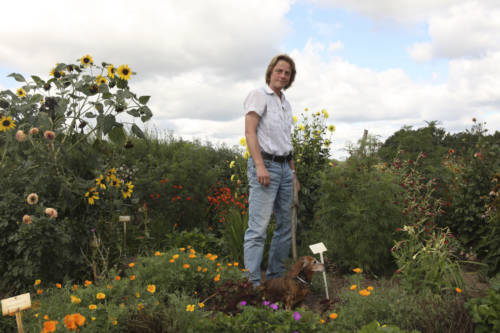
How The Spree Forest Medicinal Garden Became Known For Its “Remedy Botany”
The Spree Forest medicinal garden is nestled on a main road in the contemplative village of Dissen in Brandenburg, Germany. Visitors to the area are apt to have heard about the Remedy Garden’s enchanting lore because of the famous Spreewald Biosphere Reserve located in the area, though I never knew of the garden until visiting this summer. Chairwoman Susan Leber met me on site to walk the property and discuss her association’s role in the ancient (but continually pioneering) trade of medicinal gardening, which has been in practice at Spreewald for over 25 years.
Until the end of last year, the medicinal garden at Spree Forest was farmed on a piece of land at a different location. Today, it’s unbelievable that the rectangular plot has only been planted for half a year, as flowers and greenery remain lush for as far as the eye can see.
The reason for the move was circumstantial: when the garden’s lease was suddenly not renewed at the end of last year, a relocation had to happen very quickly. In the middle of winter 2015, the eight honorary members and four staff at the medicinal garden move the plot in the last six weeks of the year. All of the plants were relocated to the new site in “Stork Village”, Dissen. In entirely different soil, the major challenge for the biologists and botanists was to determine how, which, and if any of the original plantings would survive the move. Fortunately, what could have potentially have been a disastrous frost never came (at least not until the beginning of next year)– plus, the new soil had previously been fertilized as the area was frequently trafficked by fallow deers who used the region for breeding (and for carrying out other soil-enriching bodily functions).
“If you want to drink it, it doesn’t taste bad enough,” she laughed, recalling what she told her ailing sibling. After 2-3 cups, his health seemed to have returned…
Leber’s employment with the biosphere reserve “Spreewald” means that she is in charge of species and habitat conservation. She and her colleagues gathered the plants on their extensive field operations and she now finds dry grasslands, forests, wetland areas, and lakes areas all within her region. This kind of landscape diversity results in a wide variety of plants, the inventory of which exceeds over 600 specimens.
Here in medicinal garden, these plants are bred as cultural and historical crops, in addition to being used for public education. “The Spreewald”, as the adjoining UNESCO biosphere reserve is called, also includes many species that are now endangered in the wild because of intensive farming with fertilizers, monoculture, and mowers. As a result, special attention is paid to maintaining the land and its species’ vigor for future generations.
Leber gives me a personal introduction to comfrey, an herb that can be used internally (taken as a tea or tincture) or externally (used as an ointment, in compresses, or in alcohol form to aid digestion). Comfrey, I learn, is also used for treatment of disorders in the locomotor system and gastrointestinal tract. While comfrey is just one of her staple crops, the medicinal garden is also a hotbed for valuable bitter plants. When Leber’s brother returned from South America with painful abdominal cramps, she gave him a tea made from wormwood, mugwort, and Southernwood. (Importantly: no sugar, no honey!)
“If you want to drink it, it doesn’t taste bad enough,” she laughs, recalling what she told her ailing sibling. After 2-3 cups, his health seemed to have returned.
While anecdotes like this are common among herbalists and naturopaths (for which growers in Germany are famous), overall, the staff’s main goal is to contribute to biodiversity. Trained members and staff gather the seeds of plants, and visitors can buy them to sow in their own gardens. Because of this delicate system of exchange, many varieties of valuable medicinal plants find new prosperity in the private gardens of visitors, ensuring that they will continue to be used in the future to treat even more aches and pains.










































